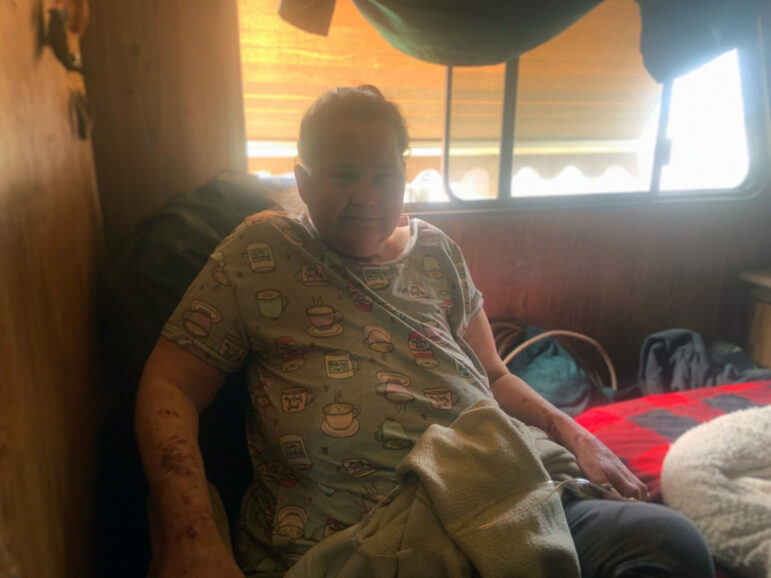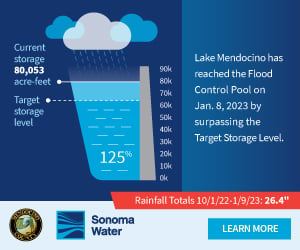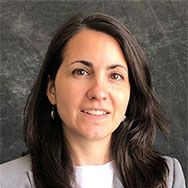WILLITS, CA, 7/25/23 — One windy night in March, Steffanie Darr and her son had finally settled into their new home at a Lake County mobile home park. The steps up to the trailer were damaged beyond use during their move, but inside still felt familiar. To keep the elements out, the Darrs used bricks to hold down a tarp over the trailer’s leaky roof. But in that night’s atmospheric river storm, one of more than a dozen that swept California this year, the bricks went flying and broke the trailer’s awning.
“We’ve had to fight and claw just to stay alive,” Darr said.
For several years, the Darrs lived in relative calm at Creekside Cabins & RV Resort, a mobile home park in eastern Mendocino County. They kept to themselves but knew and befriended neighbors; the “people of the park,” as Darr calls them, took care of each other.
But on Dec. 30, a storm collapsed the culvert supporting the only access road to the mobile home park, trapping them and about 60 other residents for nearly a month. Creekside residents spent three weeks climbing across the gaping pit onto busy Highway 101 to get to the outside world. Supplies and spirits were bolstered with periodic visits from Social Services and local nonprofits, but information about a permanent fix remained murky.
In late January, Mendocino County declared a Public Health Emergency after finding traces of E. coli in the property’s water. Officials declared that the county could not implement a permanent fix on private property — instead, Mendocino County would install a temporary bridge to allow vehicle passage out of the park, to the tune of $250,000. Open during daylight for just two days (a total of 16 hours), the bridge was Creekside residents’ only chance in the foreseeable future to move their belongings and lives out of the park. The bridge opened Wednesday and Thursday of the last week in January, and was removed that Friday.
When it comes to the impact of climate change, the Darrs’ experience is textbook according to a report from California’s Fourth Climate Change Assessment. The report found that vulnerable populations in Mendocino County and other rural Northern California communities would be disproportionately affected by “climate-driven disruptions,” such as infrastructure failure. Populations including low-income people, people of color, women, older adults, people with disabilities, people with existing health struggles including mental health issues, and people with limited English proficiency are often less equipped to adapt and recover following climate disaster.
In a climate of increasing extremes in Northern California, Governor Gavin Newsom is investing in climate projects to an historic degree— around $48 billion has been allocated over the next five years, though the initial package was cut by $6 billion. Though environmentalists have reservations, the governor is also implementing permitting and project review reforms meant to accelerate the building of clean infrastructure.
The state also has a number of wide-ranging climate goals through the California Climate Adaptation Strategy. A report on resulting projects in 2022 highlighted the Scotts Valley Band of Pomo Indians’ work to convert a 10-unit motel into affordable housing for unhoused indigenous community members — an example of state-funded rural climate adaptation in fire-prone Lake County, near the Darrs’ new home.
Despite these investments, extreme weather linked to climate change is having a profound effect statewide, harming those with fewer resources to adapt and stretching the capabilities of local emergency responders and social services.
“A lot of the resources that the state is investing in climate adaptation are directed towards disadvantaged communities,” said Theodore Grantham, a professor at the University of California, Berkeley and the lead author of the North Coast portion of the Climate Change Assessment. “But I would say that there’s certainly more attention being given to the urban, more densely populated regions of the state than the rural parts of the state.”
He sees lesser investment in infrastructure as one of the biggest challenges facing rural regions when it comes to climate resiliency. It can be hard to justify labor-intensive, costly upgrades or maintenance that will help relatively few people.
Accumulating disasters have a higher impact
Prior to the collapse in December, Darr and her son noticed that the creek still held debris from the 2021 Oak Fire, making it more likely to flood. Compounding severe weather events make outcomes like what occurred at Creekside more likely to repeat in other parts of the county or the state. In Mendocino County, average maximum temperatures are expected to increase by around seven degrees in the next 100 years, wildfires are more frequent and severe, and flooding is only expected to intensify in the North Coast region during high-precipitation years, according to the Fourth Climate Change Assessment.
“That’s really what puts this sort of unique challenge on our infrastructure, because our stormwater systems, our water supply systems, our roads, etc, are just not designed necessarily for that change,” Grantham said.
The impact goes beyond infrastructure. Increasingly volatile weather can take a huge toll on people’s lives and finances, particularly for those without extra resources to rely on. At Creekside, the majority of residents were low-income. One resident estimated that most spaces cost between $495 and $595 a month, though some did work around the property in exchange for their spot. Many people living there received Supplemental Security Income (SSI) or Social Security Disability Insurance (SSDI).
Darr herself relies on an oxygen machine and has limited mobility. She attributes some health issues to environmental disasters, including the 2021 wildfire.
“That’s why my lungs are the way they are,” she said, describing the week-long evacuation when the Oak Fire was contained just shy of their trailer and a later eight-day power outage that same year, in which she relied on a portable heater to stay warm. “This is my third [disaster], and it’s killing me.”

These experiences have taken a toll on her body, too. She was one of the lucky ones on the other side of the winter evacuation, finding a new permanent living situation back in January. But Darr still ended up living alone in her truck for days when her son was arrested on an outstanding warrant while they attempted to move. Her forearms are covered in bruises from the ordeal.
Local communities struggle to keep pace
Steffanie’s son, Steven Darr, was frustrated when Social Services representatives asked exhausted residents who’d been trapped for weeks, “What’s your emergency plan?”
“You’re making it harder on [Social Services] recipients that need help with everyday things — and you’re just expecting them to move? And then move again?” reflected Steven, who is also Darr’s In-Home Social Services (IHSS) provider.
But the county’s Social Services department was struggling, too, as residents’ safety became the subject of numerous meetings with local and state representatives. According to the multi-agency climate report, people and places with the “capacity and resilience to cope with a single exposure or environmental challenge” may then see societal systems overtaxed by “the cumulative impacts of multiple stressors.”
Mendocino County’s Social Services department has been chronically understaffed for months, with a February vacancy rate of 29%. Managing the Creekside response was an unexpected hurdle, and staff were “flying the plane while building it,” Director Bekkie Emery said in January.
In some especially isolated parts of the county, people see emergency response as a collective responsibility.
“We call it ‘the fire department and friends,’ because we all try to come running or be supportive in our own way to our fire department,” Tonie Traina-Berry, a Mendocino County resident in the high-elevation zone of Leggett, said during heavy snowstorms this winter. “Because we just wouldn’t make it without them.”
But even with community aid, whiplash from years of drought to torrential storms and back again take a toll. Emergency services in the county were exhausted in February and March, with road and rescue crews working overtime to respond to high snows, flooding, and more.
“We have all been pushed to the absolute maximum of our capabilities,” Sheriff Matt Kendall shared with the Board of Supervisors in early March.
Last year, Mendocino County’s division of Prevention, Recovery, Resilience, and Mitigation (PRRM) received a Prepare California Jumpstart grant to hold several town hall-style listening sessions focused on disaster response around the large county. The meetings were originally planned for March and April, but could not go forward because of the volume of winter disaster response.
“I guess now we have more topics to discuss,” said Travis Killmer, PRRM’s disaster recovery field operations coordinator. “We probably would have talked about drought. We probably would have talked about fire. I don’t think once-in-a-generation snowstorms would have been on the agenda previously. Now we are aware that that needs to be on the agenda.”
He is in the process of rescheduling the community engagement meetings for later this year.
Local nonprofits also shoulder these burdens. Danilla Sands, who runs United Disaster Relief of Northern California (UDRNC) — clocking between 40 and 80 unpaid hours each week and managing a growing team of volunteers — brought Creekside residents groceries and hot meals in a partnership with World Central Kitchen while they were trapped. She has also helped residents with applications for FEMA aid and other grants that could help them recover.
Sands is used to helping people get back on their feet after destruction from wildfires. This time around, aided by a grant from the Community Foundation of Mendocino County, she worked to help the many people and agencies involved support displaced Creekside residents. Five months out, that work is still ongoing.
In her role, the variability of extreme weather — from megafires to snow at improbably low elevations — drives home the need for preparedness that fits most situations.
“Do we live our whole life in fear of the next disaster, or do we learn tools for each one, to prepare ourselves?” she queried. “We should always have a go bag, regardless of what disaster it is. We should always prepare for power outages, regardless of what disaster it is. We should always have a line of communication with our family and friends. These things stay consistent.”
After the evacuation, uncertainty
After assessing the situation at Creekside, state agencies determined in January that none of the land in question actually belonged to Mendocino County: the culvert was owned by CalTrans and fell within the Highway 101 right-of-way, but was deemed the responsibility of private property manager Houser Holdings CA, LLC because it did not provide a public utility. Further, some Creekside operations had spilled off Thurman’s private land and onto land owned by California State Parks.
Back in early January, Teresa Thurman — who owns Houser Holdings — didn’t respond to a quote from the contractor who was prepared to implement a permanent fix, one construction worker said during the evacuation. The county announced plans to litigate against Thurman after finding “several health and safety violations,” though any suit has yet to move forward according to an update from county spokesperson Heather Correll Rose in late March.
Houser Holdings filed suit against CalTrans in June, saying the state agency poorly maintained the culvert leading to its collapse and claiming both damage of the property without compensation and loss of business goodwill.
After providing the bridge and mandating evacuation, the county offered vouchers to a nearby mobile home park for two months. The county also paid the Darrs’ first month’s rent in the out-of-county park where they moved. But many residents feared homelessness due to a dearth of affordable housing in the area.
In the chaos, residents were responsible for reaching out to hauling services themselves, as many of their trailers were not driveable. Darr knows one family whose trailer was not hauled out, left behind the collapsed roadway.
“It still breaks my heart,” she said. “That trailer they had was their beginning.”
Correll Rose said that 12 families that were housed temporarily at another RV park and two that were at hotels have found alternative living situations, while two remain at that park without county payment. Sands said some of the residents she works with are only this May moving into long term apartments. A few people stayed at Creekside, Sands and Correll-Rose confirmed; where the park’s driveway used to extend onto Highway 101, a hole remains.
For low-income residents, anxiety around public perception was part of the experience’s trauma, with many feeling blamed or judged for overflowing septic or garbage that hadn’t been removed because of the disaster. One father saw Creekside residents called “degenerates” on Facebook. A former resident who was helping her hospitalized friend’s daughter move out feared that, because people didn’t have the time and resources to bring all their things, “They’re going to leave it looking so bad, and then [the authorities] are going to come through here and take pictures, and say, ‘This is why it’s closed.’”
From Sands’ perspective, those feelings caused residents more harm than the disaster itself. She said, “It was about being treated like a number, or a dollar sign, or an argument.”
Preparing for the future
Grantham believes that the state has a significant role to play in helping California communities better adapt to an increasingly volatile climate.
“Carrots are probably going to get you there faster than sticks, because if you don’t have the resources, you don’t have the resources,” he said. “I think it’s really up to the state to make some of those resources available to local governments.”
In rural places like Mendocino County, some of the first steps involve identifying the weakest points before a big storm leads to the displacement of dozens.
“In many cases, we just have not seen the same sort of depth of investigation in the North Coast region as we’ve seen in the more densely populated regions of the Bay Area or Southern California, for example,” Grantham said. “With respect to everything from sea level rise to infrastructure vulnerabilities to projections of how the changing hydrology might affect the environment.”
Identifying areas like Creekside with limited alternative access routes and vulnerability to compounding extreme weather events might allow for early intervention at lower human and financial cost.
Killmer, who has been working nonstop on recovery efforts in 2023, reflected that some of that maintenance responsibility falls outside government jurisdiction. He’s learned this year that owners need to pay attention to possible danger zones on their property.
“There is a lot of private infrastructure in this county — culverts, bridges, things like that, that are pretty much aged out of their useful life at this point,” he said. “They probably should have been replaced or up for replacement, and as we see crazy rain, we’re seeing them fail. I think a lot of people maybe didn’t realize that those things needed attention.”
In her new place, Darr hopes to sit by the lake and enjoy the breeze as the seasons change — though she’s worried about how hot Clearlake has gotten in recent summers.
“The winds are horrific here,” she said of some spring evenings. “But the landlord said it doesn’t usually do that. … I kind of just had to think, where can I and my son be okay? And it was here.”






